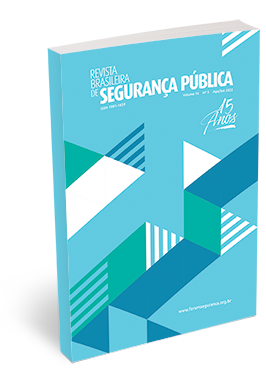Police efficiency and its indicators
DOI:
https://doi.org/10.31060/rbsp.2022.v16.n3.1445Keywords:
Efficiency of police, Indicators of efficiency, Legitimacy, ConfidenceAbstract
The present article debates the criteria used to measure the efficiency of police activity, reviewing relevant aspects of the international debate, as well as presenting the results of an empirical study on the efficiency indicators currently used by brazilian states to measure civil and military police activity. The study was based on the answers from the security departments of each state to a set of five questions, obtained through the Access to Information Law (LAI). Our findings show that the vast majority of policy makers at state level didn't have the requested information and that there is no standard for such indicators in Brazil. Also, state police use operational descriptors and criminal records as indicators of efficiency, with no consideration for the effective results in reducing crime, violence and lethality, or regarding police legitimacy and public confidence in corporations.
Downloads
References
BAUGHMAN, S. B. How effective are police? The problem of clearance rates and criminal accountability. Alabama Law BAUGHMAN, S. B. How effective are police? The problem of clearance rates and criminal accountability. Alabama Law Review, v. 72, p. 47-112, 2020.
BRODEUR, J. P. Policiamento sob medida. In: BRODEUR, J. P. (Ed.) Como reconhecer um bom Policiamento. São Paulo: Editora da Universidade de São Paulo, p. 57-82, 2002.
CANO, I. La Policía y su evaluación: propuestas para la construcción de indicadores de evaluación en el trabajo policial. Centro de Estudios para el Desarrollo, Área Seguridad Ciudadana, 2002.
GONZÁLES, Y. M. Authoritarian Police in Democracy: Contested Security in Latin America. Cambridge: Cambridge University Press, 2020.HMICFRS. Real lives, real crimes: A study of digital crime and policing. Chapter 1. Introduction, background and digital crime. 2018.
HOPE, T.; HOUGH, M. Area, Crime and Incivility: A Profile from the British Crime Survey. HOPE, T.; SHAW, M. (Eds.). Communities and Crime Reduction. London: H. M. Stationery Office, p. 21-89, 1998.
JACKSON, J.; BRADFORD, B.; HOUGH, M.; MYHILL, A.; QUINTON, P.; TYLER, T. R. Why do people comply with the law? Legitimacy and the influence of legal institutions. The British Journal of Criminology, v. 52, n. 6, p. 1051-1071, 2012.
KIRBY, Stuart. Effective Policing? Implementation in Theory and Practice. Palgrave Macmillan (UK), 2013.
KOPITTKE A. L. W. Segurança Pública e Democracia no Brasil: uma história de desencontros. Dissertação (Mestrado em Ciências Criminais) – Pontifícia Universidade Católica do Rio Grande do Sul (PUCRS), Porto Alegre, 2016.
MASTROFSKI, S. D. Policing for People. Ideas in American Policing, Police Foundation, mar. 1999.
MAZEROLLE, L.; SARGEANT, E.; CHERNEY, A.; BENNETT, S.; MURPHY, K.; ANTROBUS, E.; MARTIN, P. Procedural Justice and Legitimacy in Policing. SpringerBriefs in Criminology, Translational Criminology. Fairfax, VA, USA, George Mason University, 2014.
MCLEAN, K.; WOLFE, S. E.; ROJEK, J.; ALPERT, G. P.; SMITH, M. R. Police Officers as Warriors or Guardians: Empirical Reality or Intriguing Rhetoric? Justice Quarterly, v. 37, n. 6, p. 1096-1118, 2019.
MOHOR, A. Uso de indicadores para evaluar el funcionamiento policial. Documento de trabajo Nº 2. Centro de Estudios en Seguridad Ciudadana, Universidad de Chile, 2007.
MONTEIRO, J.; FAGUNDES, E.; GUERRA, J. Letalidade policial e criminalidade violenta. Revista de Administração Pública, v. 54, n. 6, p. 1772-1783, nov./dez. 2020.
PEREIRA, J. D. Avaliação de desempenho na Polícia Militar do Espírito Santo. XXXIII Encontro da ANPAD. São Paulo, 19 a 23 de setembro de 2009.
PLANT, J. B.; SCOTT, M. S. Effective Policing and Crime Prevention: A Problem-Oriented Guide for Mayors, City Managers, and County Executives. U. S. Department of Justice Office of Community Oriented Policing Services, 2009.
REINER, R. Processo ou Produto? Problemas de Avaliação do Desempenho Policial Individual. In: Brodeur, J. P. (Ed.). Como Reconhecer um Bom Policiamento. São Paulo: Editora da Universidade de São Paulo, p. 83-102, 2002.
REYNOSO, L. F. L.; RIVAS, L. A.; LAMBARRY, F. TRUJILLO, M. M. La eficacia de la policía en México: un enfoque cualitativo. Polis México, v. 13, n. 2, 2017, p. 107-138, 2017.
ROLIM, M.; HERMANN, D. Confiança nas polícias: percepção dos residentes e desafios para a gestão. Sociologias, v. 20, n. 48, p. 188-211, 2018.
SILVA, J. A. Sistema de indicadores de atividade policial militar. Segurança, Justiça e Cidadania: Pesquisas Aplicadas em Segurança Pública, p. 87-138, 2008.
SILVA, L. A. M.; LEITE, M. P. Violência, crime e polícia: o que os favelados dizem quando falam desses temas? Sociedade e Estado, v. 22, n. 3, p. 545-591, 2017.
SKOGAN, W. G. Disorder and Decline: Crime and the Spiral of decay in American Ciries. New York: Free Press, 1990.
SKOGAN, W. G. Efficiency and Effectiveness in Big-City Police Departments. Public Administration Review, v. 36, n. 3, p.278-286, 1976.
SKOGAN, W. G.; HARTNETT, S. M. Community Policing. New York: Oxford University Press, 1997.
SOARES, L. E. Meu Casaco de General: quinhentos dias no front da segurança pública do Rio de Janeiro. São Paulo: Companhia das Letras, 2000.
SOARES, L. E. Medidas impulsionam ‘audácia antidemocrática’ das polícias, diz antropólogo. O Estado de São Paulo, Caio Sartori, São Paulo, 12 jan. 2021.
WILSON, J. Q. KELLING, G. L. Bronken Windows: The police and neighborhood safety. Atlantic Monthly, v. 249, n. 3, p. 29-38, 1982.
ZANETIC, A. Ação institucional, confiança na polícia e legitimidade em São Paulo. Revista Brasileira de Ciências Sociais, v. 32, n. 95, 2017.
Published
How to Cite
Issue
Section
License
Copyright (c) 2022 Revista Brasileira de Segurança Pública

This work is licensed under a Creative Commons Attribution 4.0 International License.
Licensing
The Brazilian Journal of Public Security uses the Creative Commons License as a form of licensing for its published works. The license used follows the CC BY 4.0 - Attribution 4.0 International model.
To see the permitted rights please go to the full licence or to our Copyright and Licensing page.



